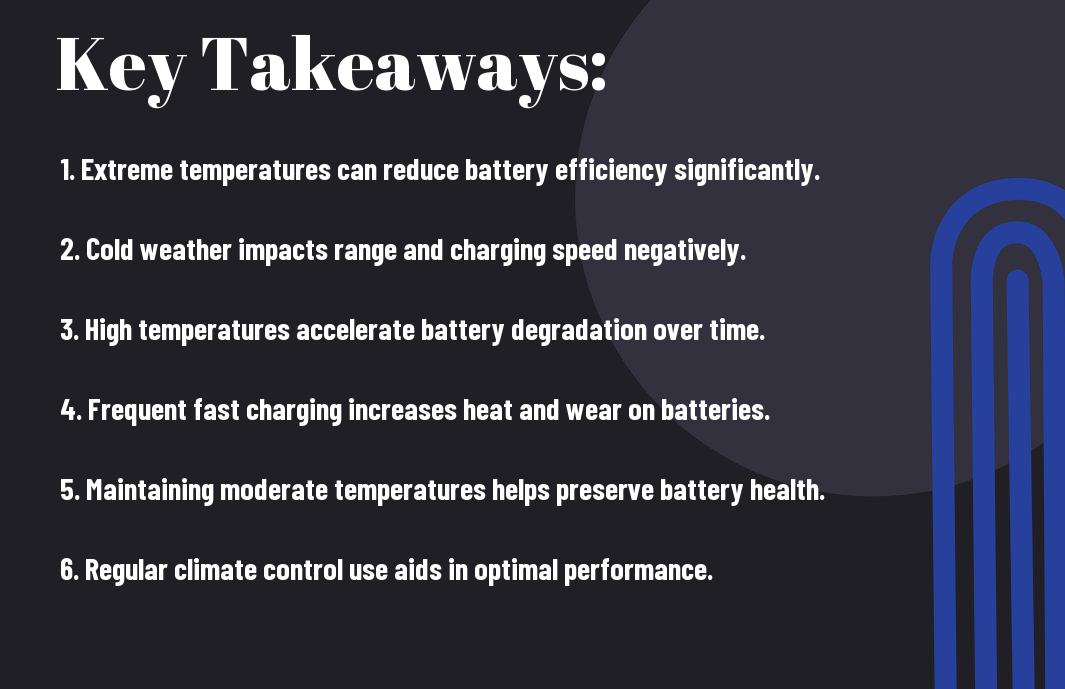With the increasing popularity of electric vehicles (EVs), understanding the factors that impact electric vehicle battery lifespan is necessary. He, she, and they should be aware that temperature and driving conditions play significant roles in battery performance and longevity. Extreme temperatures can lead to accelerated degradation, while varied driving conditions can affect efficiency and range. For a deeper understanding of temperature effects, they can explore more about How Does Heat Impact Electric Vehicles?. In this blog post, they will learn how these elements influence EV battery health and maintenance strategies.


Understanding Electric Vehicle Battery Chemistry
A comprehensive grasp of electric vehicle battery chemistry is vital to understanding how temperature and driving conditions impact electric vehicle battery lifespan. The performance and longevity of these batteries are affected by various factors, including the chemical components and reactions within the cells. For further insights on this topic, she can refer to the Impacts of Driving Conditions on EV Battery Pack Life Cycle, which explores the fundamental aspects of battery chemistry in detail.
Lithium-Ion Battery Basics
Around 90% of electric vehicles utilize lithium-ion batteries, which are favored for their high energy density and efficiency. These batteries convert chemical energy into electrical energy through a series of electrochemical reactions. Their performance can be highly sensitive to varying temperature ranges, necessitating effective thermal management systems to maintain optimal functioning.
Factors Influencing Battery Performance
Vehicle performance can be significantly affected by various factors that influence electric vehicle battery lifespan and efficiency. The following elements play a role in determining how well an electric vehicle battery performs:
- Temperature fluctuations
- Charging frequency and methods
- Driving style and habits
- Battery age and maintenance
Perceiving the importance of these factors can aid in maximizing battery utilization, ensuring longevity.
Understanding these determinants is vital for enhancing electric vehicle battery performance. Each factor can affect battery capacity and charging times, leading to variations in electric vehicle functionality and user experience. Considering them can provide consumers with valuable insights into proper battery care and usage.
- Environmental conditions
- Battery management systems
- State of charge
- Manufacturing quality
Perceiving how these elements interplay can empower users to make informed choices regarding their vehicles and battery-related practices.

The Impact of Temperature on Electric Vehicle Battery Lifespan
There’s significant evidence that temperature plays a vital role in determining the lifespan of electric vehicle batteries. Extreme temperatures can lead to accelerated aging processes, affecting battery performance and efficiency. Understanding the effect of both high and low temperatures enables drivers to take proactive measures to extend electric vehicle battery lifespan.
High Temperatures
| Effects | Description |
|---|---|
| Increased Degradation | High temperatures can lead to faster chemical reactions, reducing battery capacity. |
| Thermal Runaway | Excess heat can cause potential safety hazards, including fires. |
Impact of High Temperatures
Impact from continued exposure to high temperatures can rapidly degrade the performance of electric vehicle batteries. Reduced efficiency means drivers may experience shorter ranges and increased charging times, ultimately leading to a decrease in the overall life of the battery.
Low Temperatures
| Effects | Description |
|---|---|
| Reduced Capacity | Cold conditions can hinder the chemical reactions necessary for battery operation. |
| Slower Charging | Cold temperatures often lead to prolonged charging durations. |
Among the various temperature influences, low temperatures can also prove hazardous to electric vehicle batteries.
Battery performance declines significantly in lower temperature conditions. They can experience a reduction in usable capacity, which means that even if the battery is charged to its limit, the available power may be less than expected. Additionally, slow charging can frustrate drivers, leading to potential range anxiety and limiting driving distances.
Battery Performance in Cold
| Factor | Description |
|---|---|
| Voltage Drop | Lower temperatures lead to a drop in voltage, affecting performance. |
| Internal Resistance | Cold conditions increase internal resistance, resulting in less energy delivery. |
Driving Conditions and Their Effects on Electric Vehicle Battery Lifespan
To understand how driving conditions impact an electric vehicle’s battery lifespan, one must consider various factors, including route types, traffic patterns, and driving behaviors. These elements contribute significantly to the overall performance and health of the battery. For instance, frequent stop-and-go scenarios can lead to increased energy consumption and strain on the battery, while smoother, consistent speeds help maintain battery efficiency.
Urban vs. Rural Driving
After analyzing driving patterns, it is evident that urban driving typically involves more frequent stops and starts, influencing battery performance negatively. In contrast, rural driving usually allows for steadier speeds and better energy efficiency, leading to a more favorable impact on electric vehicle battery lifespan.
Aggressive Driving vs. Moderate Driving
With aggressive driving, characterized by rapid acceleration and hard braking, the battery experiences increased strain and energy depletion. Moderate driving, however, promotes energy efficiency and can enhance electric vehicle battery lifespan through smoother transitions and less energy consumption.
Conditions of aggressive driving not only deplete battery reserves quickly but can also result in elevated temperatures within the battery, further diminishing its lifespan. Regular hard acceleration generates higher demands on the electric motor and battery. Conversely, drivers who adopt moderate driving practices—maintaining a steady pace and gentle acceleration—tend to optimize their vehicle’s energy efficiency. This approach allows for better thermal management and extends battery life, making it a more sustainable driving habit over time.

The Role of Charging Practices on Electric Vehicle Battery Lifespan
Your charging practices significantly impact the lifespan of electric vehicle batteries. Implementing proper charging habits can help maximize battery health, ensuring longevity and performance. Factors such as charging speed, frequency, and depth of discharge all come into play, influencing the overall efficiency and durability of the battery over time.
Fast Charging Implications
About fast charging, it offers convenience but can generate excess heat and increase battery stress. Regular use of fast chargers may shorten electric vehicle battery lifespan due to the rapid energy transfer, which places additional strain on battery cells. Users should consider using standard charging options for daily needs to mitigate these risks.
Optimal Charging Habits
Across various studies, optimal charging habits suggest maintaining a battery charge between 20% and 80% for improved longevity. Frequent full cycles, both charging to 100% and depleting to near zero, can accelerate wear and tear. This practice fosters a balanced state of charge that is less taxing on the battery.
With a focus on maintaining the battery’s optimal state, individuals can benefit from establishing consistent charging routines. They should aim for partial charges rather than full ones and avoid deep discharges that can lead to accelerated degradation. In fact, experts often recommend scheduling nightly charging sessions to ensure the battery regularly operates within its ideal range, ultimately prolonging its electric vehicle battery lifespan and efficiency.
Environmental Considerations
Despite the advancements in technology, environmental factors such as temperature and weather can significantly influence the lifespan of electric vehicle batteries. These conditions affect the battery’s performance and efficiency, thus impacting the overall driving experience and longevity. As electric vehicle adoption continues to rise, understanding the influence of environmental elements becomes increasingly important for consumers and manufacturers alike.
Weather Patterns
After observing the effects of varying weather patterns, it becomes clear that regions with extreme highs or lows can impose stress on electric vehicle batteries. These fluctuations can lead to decreased performance and may necessitate more frequent charging, ultimately affecting the battery’s lifespan over time.
Seasonal Changes
The impact of seasonal changes on electric vehicle batteries cannot be overlooked. Each season brings unique temperature variations and weather conditions that can either enhance or degrade battery performance. For instance, prolonged exposure to cold temperatures can slow down chemical reactions in the battery, resulting in reduced capacity and efficiency.
With the transition from one season to another, electric vehicle owners may notice changes in battery efficiency and range. In winter, frigid temperatures can lead to diminished energy density, while summer heat can accelerate battery degradation. It is imperative for users to adapt their charging habits and driving behaviors according to the seasonal changes to ensure optimal battery health and performance.
Mitigating Battery Degradation
Keep in mind that proactive measures can significantly extend the lifespan of electric vehicle batteries. These strategies range from optimal driving techniques to effective climate control. By adopting these practices, drivers can mitigate the impact of environmental factors on electric vehicle battery health, ensuring reliable performance over time.
Driving Techniques
For electric vehicle owners, adopting energy-efficient driving techniques is important. Gentle acceleration, maintaining consistent speeds, and utilizing regenerative braking can reduce stress on the battery and promote longevity. Long trips at moderate speeds also help optimize battery usage, allowing for better energy management.
Climate Control Strategies
Battery thermal management plays a significant role in overall battery health.
Understanding how temperature affects electric vehicle battery performance leads to the implementation of effective climate control strategies. Maintaining the battery within an optimal temperature range, using preconditioning while plugged in, and utilizing heated seats instead of cabin heating can minimize energy consumption. Drivers benefit from these techniques, as they not only preserve battery health but also enhance overall driving efficiency, providing a smoother experience while prolonging their electric vehicle’s battery life.
Final Words
With this in mind, it is evident that temperature and driving conditions significantly influence the lifespan of electric vehicle batteries. They affect the battery’s chemical processes, efficiency, and overall performance. Extreme temperatures—whether hot or cold—can lead to accelerated degradation, making it imperative for owners to understand how to mitigate these effects. For further insights, they may explore how does ambient temperature affect EV batteries? to better protect their investment in electric mobility.



